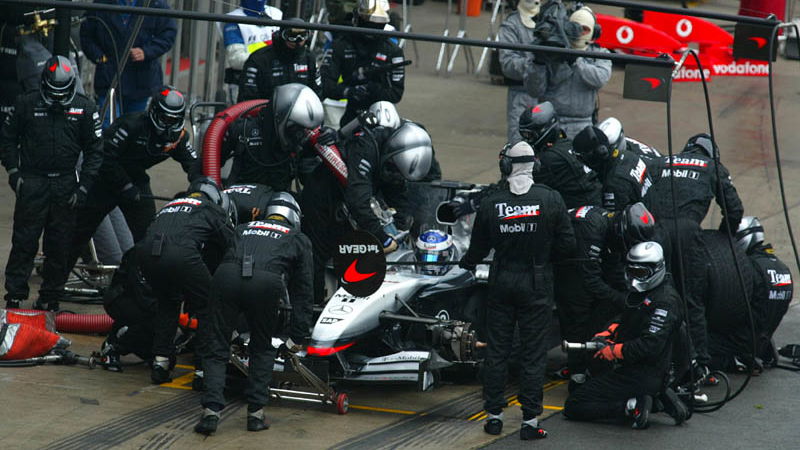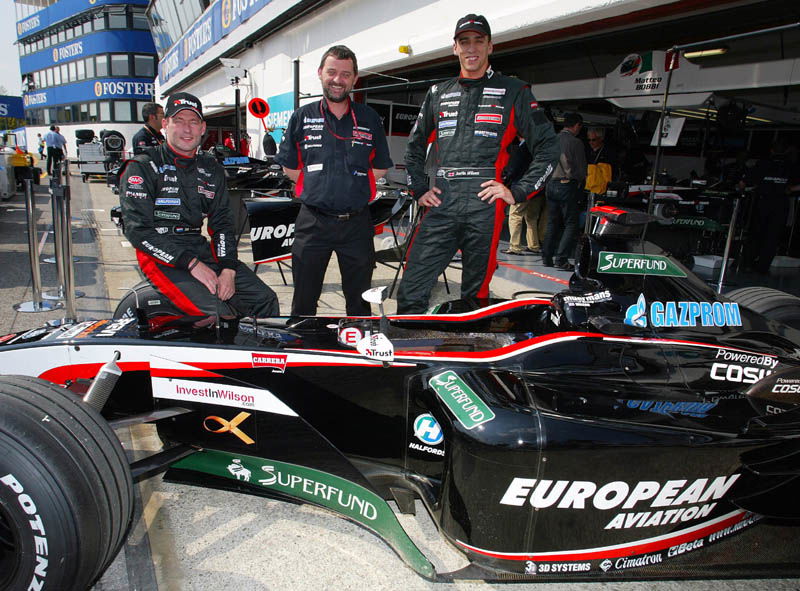F1 feature: Pit-stop equipment.
A pit-stop is one of the most dramatic moments of a grand prix, which can mean the difference between making up a place or two, or slipping down the order.
Changing four wheels and adding enough fuel for the next stint in the race takes anything from seven to twelve seconds, depending on the fuel load.
Achieving these remarkable speeds is down to a well drilled routine which the West McLaren Mercedes pit crew practices thousands of times before and during a season. It also owes a lot to specialist equipment. Let's take a look at the tools of the pit-stop trade...

A pit-stop is one of the most dramatic moments of a grand prix, which can mean the difference between making up a place or two, or slipping down the order.
Changing four wheels and adding enough fuel for the next stint in the race takes anything from seven to twelve seconds, depending on the fuel load.
Achieving these remarkable speeds is down to a well drilled routine which the West McLaren Mercedes pit crew practices thousands of times before and during a season. It also owes a lot to specialist equipment. Let's take a look at the tools of the pit-stop trade...
Hitting the mark:
When a driver comes into pit lane, his first job is to hit his "mark," the point in the pit lane where his crew are ready and waiting for him. The area is marked out with tape on the road surface. It's a very adhesive tape, applied with a special glue. It is extremely wear-resistant to cope with the drivers wheel spinning as they head back on track. Sticking up from the ground, at the point where the car stops, are earthing strips designed to prevent any discharge of static electricity which is obviously not desirable while fuel is being poured into the car. These strips are directly wired to the fuel rigs themselves to earth them out.
The lollipop:
The driver is guided into position by the "Lollipop Man," thus known as he holds a disc on a long pole similar to those used for school crossing patrols. But of course, this being Formula 1, it is no ordinary pole and it is made of carbon fibre, as a weight saving factor.
The front jack:
The driver heads for this, aiming to stop the car right over the front jack. It is made from steel tubing and is operated on the effective old fashioned leverage method with the jack-man simply pushing down on the handle to lift the car off the ground. Releasing the jack to drop the car back down again is effected by pressing a quick release handle. The team does not always use the same jack. Because of where it fits on the car, it has to be shaped to cope with a variety of front wing profiles and a tailor-made carbon pad is attached to suit each wing. The car only needs to be lifted just a couple of inches (around five centimetres) off the ground. The jacks sometimes have to be adjusted for height according to the specific demands of a pit lane. For example, the Suzuka track in Japan has a slightly cambered and downhill pit lane. The height of the jack is adjusted by changing the size of the wheels at its base to provide additional clearance.
The rear jack:
The rear jack is a simple mechanical lifter, with no need for a quick release. It needs to be light and manoeuvrable as the rear jack man is the only member of the crew who is not in position at the start of the pit stop. The reason for this is obvious, as he has to wait until the car has come past him to run in and lift the back end.
The starter motor:
The rear jack is designed to accommodate the fitting to the car of a starter motor, in the event that the car stalls as it prepares to leave the pits. It is identical to the starter used in the team garage during practice, except that it is fitted with a longer lead. This is because, on the rare occasions when a car stalls at a pit stop, it often occurs just as the car has jumped forward from its mark.
Wheel changing:
Changing wheels is the quickest part of the entire pit-stop procedure. An Italian company produces the guns used to remove and refit the wheel nuts for just about all the teams, adjusted to each one's specific requirements. Each team produces its own sockets to fit on the wheel nuts. The nuts are steel so the West McLaren Mercedes team uses magnets to retain the nut in the wheel gun when it comes off. If the gun is pulled off too quickly the nuts can sometimes fall off, but it is a very rare occurrence.
Although light weight is usually a highly prized attribute in F1, it does not apply to the wheel guns, which have to be reasonably sturdy to cope with the forces involved, as there is over 500 ft/lb (678 Newton/metres) torque involved in tightening a wheel nut. The guns operate on pressurised air, running at 20 bar pressure. To prevent the nuts coming loose, a right hand thread is used on the right side of the car and left hand on the left. Each wheel man has a spare gun and two spare nuts in case of any problems. The guns are colour coded for each side of the car. A switch on the gun changes it from the "off" to "on" position.
Refuelling:
Refuelling - the fuel filler flap on the car is automatically popped up when the driver engages the pit lane speed limiter. As the car reaches its mark, a man places a clear perspex shield on a pole behind the filler to prevent fuel spilling onto the rear end of the car, specifically the very hot exhaust system. The reason clear perspex is used is to allow the lollypop man to see when the rear tyre has been changed.
The fuel hose is pushed into place on the car by two refuellers. The refuelling rig is standardised to FIA rules, supplied to the teams who are not allowed to modify it in any way. The only customising allowed, is the method by which the refueller knows all the fuel has gone in. Some teams use an indicator which flashes up in the refueller's visor, while others, including West McLaren Mercedes, use a system of coloured lights on the back of the nozzle. The lights show when the fuel is ready to flow, that it is flowing and that the process is complete.
The nozzle pushes on. It has two sets of handles and to remove it from the car, one handle releases the latching mechanism and the second handle removes it from the connector on the car.
The amount of fuel which is dumped into the car is controlled by computer before the car arrives. It sets the rig to go and as soon as the nozzle is latched on, it starts the flow and stops it when complete.
The fuel rigs are covered with heat reflective material to keep the contents cool. The rules state that fuel can be cooled to ten degrees below the ambient temperature.
Safety:
One man operates the dead man's handle on the rig. This is an emergency requirement. The handle has to be held in place for the fuel to go in and simply released to shut it off. This means that, in the event of a major fire or explosion, letting go of the spring-loaded handle rather than making any positive movement with it is all that is needed to stop the flow. The other's car's fuel rig is always on standby in case of a problem with a third refueller ready on that hose. One mechanic is on standby with a large 60 litre capacity fire extinguisher.
